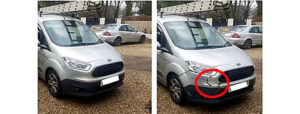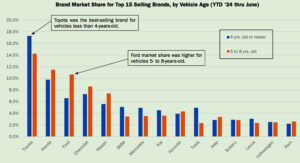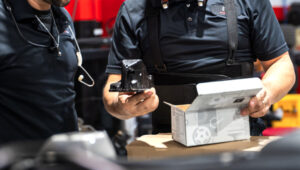Take a deep breath. Have to keep EVs in perspective
Your writer is going to break some rules today. First, he’s about to be 65, so an official old guy. And, he’s known the internal combustion engine (ICE) all his life. He tends not to be a big fan of EVs since to him it seems more political than a true technology leap. One might assume he would be somebody who saw the first car and announced that it will never replace the horse.
But you would be wrong. I’m also an automotive history buff. You see, in the late 1800s the first car someone saw was quite possibly an electric car. It started in the 1830s and then grew in the 1850s with the invention of rechargeable batteries. An EV won the 1900 land speed record. Right in front of the steam car?
The first patented electric car was built in 1894 and was called the Electrobat. Since then there have been many attempts. Remember the Electrovair II? The Impact or the Volt? It wasn’t until WWII came along that the ICE really took over. Been that way ever since. The ICE cars were less than half the price of the EV. For all intents, still are!
The typical EV buyer today is the same as “back in the day.” Younger, male, short commutes, wealthy (or very well paid), professional, is an early adapter of things technical, quite frequently wanting to virtue signal. FYI, a bumper sticker is a lot less expensive. And he is very likely to have a large ICE vehicle in his driveway for serious trips. Maybe a big old class A RV. Looks good next to the super duty pick-up.
One thing that has changed is that tax payers are now subsidizing the buyers and the industry. Depending on what poll you read roughly 29% to 50% of the population would consider buying an EV. FYI, most all of the top end polls are by organizations trying to push EVs.
Having been a college teacher of stats once upon a time, statistics can quite often be made to push the agenda of the “poller.” Twenty percent of those who bought EVs want out now. And, the share of the population wanting to buy an EV fell this year over last. Whatever happens in the next administration, subsidies could end, and so could a lot of maybe buyers.
Two factors stand out in the slow adaption of EVs. The first is price. As mentioned, subsidies have helped lower the bar a bit. But subsidies come and subsidies go. The second is the charging structure. As I made my way through piles of reports and reviews, there is a short but major list of cons relative to buying EV.
- Lack of convenience
- Using a public charging station isn’t always an enjoyable way to spend your time. As one writer mentioned, he used a fast charge location and it still took him through two hamburgers and coffee. And, they are very far apart, and are often known to be out of service. Not cheap either now that there is a fee to charge at many, if not most.
- Using a home station isn’t much fun either. First there’s the thousands of dollars with getting a station installed. Then there’s the electric bill which was supposed to use about 3KW to charge each time that is really taking two times that and more. And if you rent in a complex, you either have a landlord who will allow you to put in a charger on your nickel, or buy a very long extension cord!
- It is extremely unusable in rural areas, not a stellar cross country vehicle. And, in test after test on light trucks for commercial use the ranges, if lucky, might make 150 miles. Add a trailer and down she goes. The batteries also don’t like temperature and weather extremes. So the reported range means little. Use, where located and habits mean a lot more.
While we’re on the subject of batteries do consider that LION (or Li-on) batteries tend to burn with some frequency. Just ask the ship’s captain that lost hundreds of cars and his ship when one EV decided it was time to burn.
Or the rules at some race tracks that LION cars be parked at least 30 feet from any other vehicle. Or the hundreds of people who have lost homes to their car, EV bicycle or scooter that started a fire. People died too. The fire starts as what’s called thermal runaway. Once the cycle starts the batteries will burn very hot and very fast.
And lest we forget, the source of electricity. Since all of the solar and wind energy is about 10% of demand and unlikely to get much higher any time soon, power is typically provided by coal, natural gas or nuclear sources.
And, there’s the environmental issues having to do with the trashing of land and water mining lithium in China or the child labor and public health problems around cobalt mining in the Congo. Then it is really critical to look at how power moves from those sources to the end user. In California, home of most EV’s, there are times in the summer when EV charging must be curtailed because the electrical grid cannot handle the demand.
While we’re are on the subject of the batteries, there are two more environmental issues. First the power and materials used in their assembly. Then there’s the problem of getting rid of them. We are just early in the LION stage. While there are a few other battery technologies, none has proven as energy dense as LION.
Tesla, far and away the biggest EV manufacturer, offers three different warranties on their battery and powertrain, the highest 8 years or 150,000 miles, whichever comes first, on a battery that has 70% or less charge retention. They do provide 4 years or 50,000 miles for a used Tesla.
In any event we are just a few years away from having to construct one dandy landfill. While ICE engines are fully recyclable without special handling, such is not the case for EV LION batteries.
The vehicle manufacturers are next. In the early 1900’s there were dozens of EV manufacturers. They are all gone. Today, there are once again dozens. Their future is yet to be told. But, there is one difference. While most are start-up, the big automakers are in it too. My opinion only, but I think we can just follow the dollars. They are being hugely subsidized in this deal.
Manufacturers are also being pushed by CARB states in particular which is more the result of politics than science. And, the multi-billion dollar industry created around climate change. Ford is losing over $4.5 billion dollars this year on EV’s. According to Reuters they are pulling money out of EV and putting it into the commercial truck group and gas/electric hybrid development. Smart move.
Last year Tesla, EV market leader by a long way, had sales of 910,000 vehicles in 2022. That’s .003% of the vehicle feet of 283 million in our nationwide fleet. Granted they sold cars before and since 2022, but the data suggests that contrary to media of all types, the EV isn’t a really big deal. Unless you happen to pay income taxes. Sorry, had to add that.
As it stands, the future for EV is trillions of dollars and years away from really happening at any cataclysmic level. No doubt it is great to look at batteries, along with a wide range of technology and fuel possibilities. Could be, like in the 1900’s electricity joins steam in the closet of tried repeatedly and not practical technologies.
What’s it all mean for repair and support for the independent aftermarket?
- Plenty of sour stomachs in our manufacturing companies, warehouses, jobbers and retailers as they deal with a SKU count that grows exponentially, doesn’t move much and costs plenty of inventory dollars.
- At the service repair level it means special training in handling EVs. And for our first responders and others given the high power charges in these things and the thermal runaway fires.
- Realize that EVs are a pittance of the market today. It’ll mean training and new tools just like the fuel injection of the 80’s and onboard computers. It is an evolution, not a revolution. We’ll be working on cars, however they are powered. Have to come up with a new name for techs. Now they’ll be both mechanical and electrical engineers. The tech schools are all part of this too.
- As always, the technology will start at the coasts and move in. Remember, California is the biggest EV market now.
We could go on and on with this subject. But, while it’s an issue for the aftermarket, it’s not a disaster. Just one more thing we’ll all have to learn and handle. You now have my permission to sit a few minutes and have a cup of coffee. And, maybe a donut. And a deep breath.
To fellow writers and readers, rather than list the sources in detail for all of this, which would be in the dozens, I did use info from Reuters, Hedges & Co., Automotive News, Car & Driver, USA Today, Pew Research/Experian, University of Stanford and lots more.










Comments are closed.